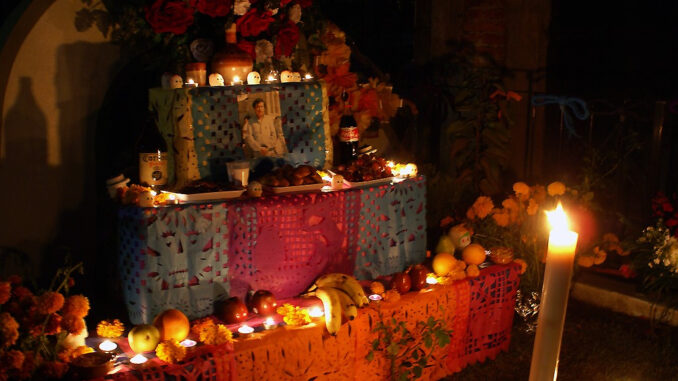
Emily Fritz | Staff Writer
Nov. 3, 2022
Día de los Muertos, or Day of the Dead, is a holiday that originated in the Latinx community to honor and celebrate loved ones who have died. Unlike other cultural traditions, Día de los Muertos is a celebration of loved ones after death, instead of a somber and grief-driven occasion of mourning. The imagery in this holiday includes many smiling and gleeful calaveras (skulls) to emphasize a friendly nod to death.
Timeline
The first 24 hours, starting at midnight on Nov. 1, is referred to as Día de los Angelitos, or Day of the Little Angels, and honors the children who have died. Traditionally, families will adorn their ofrendas with sugar skulls that have the deceased child’s name written on them. To encourage a visit from their dearly departed, they will also set out the child’s favorites candies, toys and snacks alongside their photo.
Día de los Difuntos starts at midnight on Nov. 2 and focuses on celebrating deceased adults. In lieu of candies and toys, family members will set out alcoholic beverages, such as tequila, mezcal and pulque, along with pan de muertos (Day of the Dead bread) and Atole (a thick, non-alcoholic Mexican beverage). This time is characterized by family games, dancing and music from local musicians.
Día de los Muertos, or Spirits of All the Dead, begins at noon on Nov. 2. This is when family members wear the well-known skeleton face paintings and visit the graves of those they love to clean, restore and decorate them with marigold flowers and gifts.
La Catrina
A commonly used figure of the holiday is La Catrina. Jose Guadalupe Posada, an artist from the early 20th century, created a satirical painting of a female skeleton wearing an extravagant feather hat and dressed in wealthy European style clothing.
Her attire was intended as a backhanded commentary about locals who wished for riches and Eurocentric luxuries. Posada used La Catrina’s boney appearance to convey the idea that after death, we are all the same. After death, we are all reduced to the sameness of our skeletons, despite our material possessions during life.
Ofrenda
The ofrenda, or ‘altar,’ is treated as a beacon for the dead to return to. Families fill their ofrendas with food, drink, alcohol and marigolds to encourage their loved ones to come home and enjoy what they once did in life.
It is unclear whether the ofrenda came from the Mesoamerican roots of the culture and the food offerings that were made to the dead, or if the traditions of the ofrenda came from the Catholic undertones of the holiday.
The most common set-up of the ofrenda consists of two or more levels, with pictures and possessions of the deceased on the upper most platforms of the altar. The ofrenda is decorated with brightly colored tablecloths, papel picados (colorful tissue paper cut into elaborate designs) and marigolds.
On the lowest level of the ofrenda are the offerings. Food offerings on the ofrenda can include traditional Mexican foods, such as tamales and mole or oranges and sugarcane, in addition to holiday specific foods such as sugar skulls and pan de muerto.
Food
In addition to popular Mexican dishes like tortilla soup, tamales, chalupas, calabaza and caramel flan, holiday-specific dishes include pan de muertos and calaveras de azúcar.
Pan de Muertos, or Day of the Dead bread, is a sweet soft pastry dusted with sugar and topped with bone-inspired decorations. Calaveras de Azúcar, or sugar skulls, are hard edible ornaments made from sugar and water that are decorated with colorful icing and the names of family and friends.
Sugar skulls hold special significance with the merging of Pre-Hispanic and Spanish customs, but also reestablishes the celebratory nature of Día de los Muertos. Instead of reinforcing the narrative of sadness and loss, the holiday fondly remembers and reinvites loved ones back into the realm of the living. Likewise, the sugar skulls wear a sly smile, almost to mock the idea of death.
Día de los Muertos is not a holiday exclusive to Latinx culture. Many other cultures and communities celebrate the day following Halloween by honoring the lives and legacies of loved ones passed. What sets Día de los Muertos apart from other All Saint’s Day celebrations are the historical and cultural influences as well as the optimistic perspective towards those experiencing life after death and our continued relationship with them.
All information about the customs, traditions and celebration of Día de los Muertos was derived from www.dayofthedead.holiday.

